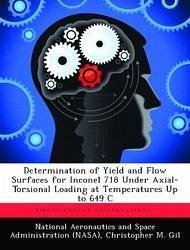An experimental program to determine flow surfaces has been established and implemented for solution annealed and aged IN718. The procedure involved subjecting tubular specimens to various ratios of axial-torsional stress at temperatures between 23 and 649 C and measuring strain with a biaxial extensometer. Each stress probe corresponds to a different direction in stress space, and unloading occurs when a 30 microstrain (1 micro eplison = 10(exp -6) mm/mm) offset is detected. This technique was used to map out yield loci in axial-torsional stress space. Flow surfaces were determined by post-processing the experimental data to determine the inelastic strain rate components. Surfaces of constant inelastic strain rate (SCISRS) and surfaces of constant inelastic power (SCIPS) were mapped out in the axial-shear stress plane. The von Mises yield criterion appeared to closely fit the initial loci for solutioned IN718 at 23 C. However, the initial loci for solutioned IN718 at 371 and 454 C, and all of the initial loci for aged IN718 were offset in the compression direction. Subsequent loci showed translation, distortion, and for the case of solutioned IN718, a slight cross effect. Aged IN718 showed significantly more hardening behavior than solutioned IN718.








